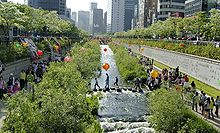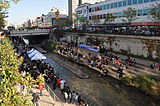Cheonggyecheon
| Cheonggyecheon | |
 Cheonggye Stream in downtown Seoul | |
| Korean name | |
|---|---|
| Hangul | 청계천 |
| Hanja | |
| Revised Romanization | Cheonggyecheon |
| McCune–Reischauer | Ch'ŏnggyech'ŏn |
Cheonggyecheon (Hangul: 청계천) is an 8.4 km (5.2 miles) long, modern public recreation space in downtown Seoul, South Korea. The massive urban renewal project is on the site of a stream that flowed before the rapid post-war economic development required it to be covered by transportation infrastructure. The $900 million project initially attracted much public criticism but, after opening in 2005, has become popular among city residents and tourists.
Geography
Cheonggyecheon is a 5.8 km creek flowing west to east through downtown Seoul, and then meeting Jungnangcheon, which in turn connects to the Han River and empties into the Yellow Sea. During the 1948-1960 presidency of Syngman Rhee, Cheonggyecheon was covered with concrete for roads. In 1968, during the presidency of Park Chung-hee, an elevated highway was built over it.
History

The stream was named Gaecheon ("open stream") after the first refurbishment project to construct a drainage system during the Joseon Dynasty. The work, which included dredging and bolstering the banks of the stream and building the bridges, was carried out every 2~3 years during this period from the reign of Taejong, the third king of the Joseon Dynasty. King Yeonjo especially undertook the refurbishment work as a national project.[1]
Gacheon was renamed to Cheonggyecheon, its current name, during the Japanese colonial period. During this time, financial difficulties prevented the colonialists from covering up the stream despite several attempts to do so.[2]
After the Korean War (1950–1953), more people migrated into Seoul to make their living and settled down along the stream in shabby makeshift houses. The accompanying trash, sand, and waste, and deteriorating conditions resulted in an eyesore in the city. The stream was covered up with concrete over a 20 year period starting in 1958, and a 5.6 km-long, 16 m-wide elevated highway was completed in 1976. The area became an example of successful industrialization and modernization of South Korea.[2]
Restoration

In July 2003, then-Seoul mayor, Lee Myung-bak initiated a project to remove the elevated highway and restore the stream. It was a major undertaking as not only did the highway have to be removed, but as years of neglect and development had left the stream nearly totally dry, 120,000 tons of water were to be pumped in daily from the Han River, its tributaries, and groundwater from subway stations.[3] At that time, safety problems also occurred due to the deteriorated concrete construction. Despite this, restoration of Cheonggyecheon was deemed important as it fit in with the movement to re-introduce nature to the city and to promote a more eco-friendly urban design. Other goals of the project were to restore the history and culture of the region, which had been lost for 30 years, and to revitalize the economy of the metropolis, Seoul.
The Seoul Metropolitan Government established several organizations to oversee the successful restoration of Cheonggyecheon: the Cheonggyecheon Restoration Project Headquarters for the control of the whole project, the Citizen's Committee for Cheonggyecheon Restoration Project for the management of conflict between the Seoul Metropolitan Government and the union of merchants, and the Cheonggyecheon Restoration Research Corps for the establishment and review of the restoration plan.
To address the consequent traffic problem, the Cheonggyecheon Restoration Project Headquarters established traffic flow measures in the downtown section affected by the restoration work and coordinated changes in the downtown traffic system based on the research of the Cheonggyecheon Restoration Research Corps.[2]
The restoration of two historic bridges, Gwangtonggyo and Supyogyo, was also a contentious issue, as several interest groups voiced opinions on how to restore historical and cultural sites and remains, and whether to replace the bridges or not.[2]
The Cheonggyecheon restoration project had the purpose of preserving the unique identity of the natural environment and the historic resources in the CBD of Seoul, and to reinforce the surrounding business area with information technology, international affairs and digital industries.[2] The plan also encouraged the return of the pedestrian-friendly road network connecting the stream with traditional resources, e.g. Bukchon, Daehangno, Jungdong, Namchon and Donhwamungil. This network system, named the CCB (Cheonggyecheon Culture Belt), tried to build up the foundation of cultural and environmental basis of the city.
Achievements
The stream was opened to the public in September 2005 and was lauded as a major success in urban renewal and beautification. However, there was considerable opposition from the previous mayoral administration of Goh Kun, which feared gentrification of the adjacent areas that housed many shops and small businesses in the machine trades.
Creating the environment with clean water and natural habitats was the most significant achievement of the project. Species of fish, birds, and insects have increased significantly as a result of the stream excavation.[4] The stream helps to cool down the temperature on the nearby areas by 3.6 °C on average versus other parts of Seoul.[5] The number of vehicles entering downtown Seoul has shown a decrease of 2.3%, with an increasing number of users of buses (by 1.4%) and subways (by 4.3% - daily average of 430,000 people) as a result of the demolition of the two heavily-used roads.[6] This has a positive influence by improving the atmospheric environment in the region.
The project attempted to promote the urban economy through amplifying urban infrastructure for a competitive city within the existing business and industrial area centered on the stream. The Urban renewal project was the catalyst of revitalization in downtown Seoul. Cheonggyecheon became a centre for cultural and economic activities.
Cheonggyecheon restoration work also brought balance to the areas both in south and north of the stream. During the modernization era, downtown Seoul was divided into two parts, north-south, based on their features and function. The restoration helped to join these two parts in order to create a new urban structure connecting the cultural and environmental resources in northern and southern areas of the stream (Hwang n.d.), resulting in a balanced and sustainable development of northern and southern areas of the Han River.
The project resulted in a speeding-up in traffic around the city when the motorway was removed. This has been cited as a real-life example of Braess's paradox.[7]
Cost
Budgeted at 349 billion won, the final cost of the project was over 386 billion won (approximately US$ 281 million).[2] Some Korean environmental organizations have criticized the project for its high costs and lacking ecological and historical authenticity, calling it purely symbolic and not truly beneficial to the city's eco-environment. Instead of using the restoration as an instrument of urban development the environmental organizations have on contrary called for a gradual long-term ecological and historical recovery of the entire Cheonggyecheon stream basin and its ecological system.[8]
The cost of managing Cheonggyecheon has been rising every year.[9]
Photos
-
A long park runs on both sides of the stream.
-
The beginning of the Cheonggye Stream
-
Cheonggye Stream flowing through Seoul
-
Cheonggye Stream in winter
-
The beginning of the Cheonggye Stream at night
-
The Cheonggye Stream at night
-
The Cheonggye Stream east of Dongdaemun Market
-
Live entertainment on Cheonggye Stream near Dongdaemun Market
See also
References
- ^ PDF, in Korean. Retrieved on 2010-11-21.
- ^ a b c d e f Official website of Cheonggyecheon, Retrieved on 2010-11-21.
- ^ * Park, Kil-dong. (2007). Cheonggyecheon Restoration Project.
- ^ Urban waterways: Seoul peels back the pavement and reveals a river - Cheonggyecheon, Livable cities, Seoul | TerraPass: Fight global warming, reduce your carbon footprint. TerraPass (2009-07-17). Retrieved on 2010-11-21.
- ^ donga.com[English donga]. English.donga.com (2005-08-12). Retrieved on 2010-11-21.
- ^ [1]
- ^ Easley, D and Kleinberg, J: "Networks", page 71. Cornell Store Press, 2008
- ^ Cho, Myun-Rae. (2010). "The Politics of Urban Nature Restoration".
- ^ Kang (강), Gyeong-ji (경지) (2011-11-20). "청계천 물길 따라 해마다 80억원 증발". edaily (in Korean). Retrieved 2011-12-03.
Further reading
- M.-R. Cho, "The Politics of Urban Nature Restoration, The Case of Cheonggyecheon Restoration in Seoul, Korea," International Development Planning Review, Vol. 32, No. 2, 2010.
- J. H. Shin, "Dream and Hope of Korea, Cheonggyecheon Restoration," Magazine of Korean Water Resources Association, Vol. 37, No. 1, 2004.
- B. Križnik, "Urban Regeneration in Global Seoul: New Approaches, Old Divides?" Wiener Beiträge zur Koreaforschung, Vol. 2, No. 1, 2010.
External links
- Cheonggyecheon Seoul Metropolitan Facilities Management Coroporation
- Cheonggyecheon Official Seoul City Tourism Website








